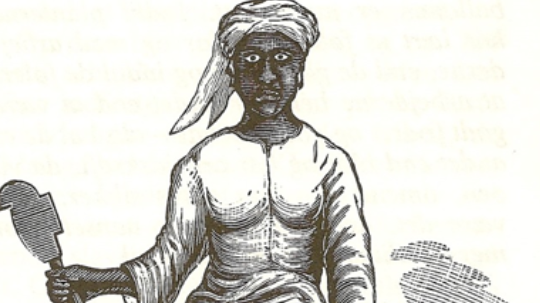Photo: Wikimedia Commons
Above is a depiction of “Queen” Mary Thomas one of the three Black female leaders of St. Croix’s infamous 1878 “Fireburn” Labor Revolt.
Even after the abolition of slavery, conditions in the Danish colony of St. Croix (now U.S.V.I.) were very tough. Frustration and unrest were brewing. In 1878, a violent rebellion took place in which houses, sugar mills, sugar fields, and over half the city of Frederiksted burned down. Three women, Mary, Agnes, and Mathilda, were especially active in the rebellion.
Today, they are considered heroines in the islands.
The immediate reason behind the rebellion in 1878 was that rumors about improvements in the strict labor rules from 1849 turned out to be groundless. The population was frustrated that conditions largely had not improved after the abolition of slavery. Furthermore, the 1870s had been characterized by lean harvest years.
The Fireburn and the Three Queens
October 1 was Quarter Day – the one day a year where the workers could change plantations. On this day, many celebrated their short-term feeling of freedom. Things developed, and the following days houses, sugar mills, sugar fields, and stores on about 50 plantations on St. Croix were burnt down. Over half the city of Frederiksted also burnt down. The rebellion is thus locally known as the Fireburn while the Governor called it the arson rebellion.
Three women came to be the symbols of the rebellion: Mary Thomas, Axeline Elizabeth Salomon (called Agnes), and Mathilda McBean. The authorities considered them to have played a very active part in the rebellion. Locally, they were known as “queens”.
An intense court battle
The Danish authorities harshly put down the rebellion. Around one hundred of the Black population lost their lives, most of them shot in fighting with the military. Only three Europeans were killed during the rebellion – two soldiers and one plantation owner.
Immediately after the rebellion, courts-martial were established in Frederiksted and Christiansted. Twelve people were given a death sentence and immediately shot. Thirty-nine were given a death sentence and sent to Copenhagen. However, 34 of them later had their sentences commuted to hard labor and the last five to imprisonment with hard labor for life. Among the latter were the three queens, Mary, Agnes, and Mathilda.
Queen Mary came to Copenhagen
The best known of the three queens was Queen Mary, who had been part of the rebellion in many places. She had become somewhat intoxicated and had shouted that those who did not want to be part of the rebellion were to be decapitated. She was also very active in vandalism and arson on the plantations. She was given a death sentence for looting and arson, but the sentence was commuted to life imprisonment.
When she arrived in 1882 at the women’s prison in Christianshavn in Copenhagen, she brought only a ring and a few earrings. She was about 40 years old and had three children, although she was unwed. She had previously been punished for mistreating one of her children and for theft. Like the other two queens, Mary served her sentence in the women’s prison until 1887, when they were sent back to Christiansted to serve out the remainder of their sentences.
Today, the local population in the West Indies has erected statues of the three women, Queen Mary, Queen Agnes, and Queen Mathilda, and one of the main roads on St. Croix is today called Queen Mary Highway.








